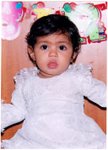It’s enough to drive any Mum up the wall. Baby is sniffling, her nose is running, she isn’t sleeping well because her nose keeps getting blocked and she is irritable. She doesn’t want to eat much food and is feeling mighty uncomfortable. As a result, you are exhausted and wish there was something to help her calm down.
Of course you need to take her to her doctor and follow what he prescribes, but there are a whole lot of other things you can do to help your baby when she has a cold.
Steam Inhalation:
Boil water in a dish with a lid. When the water is boiling vigorously, pour this into a steam inhaler or a bottle with a narrow mouth. Add a few drops of
Euclayptus oil OR
Zinda Tilismath OR
Vicks Vaporub OR
Inhalade Plus OR
Karvol / Karvol Plus Capsule.
Sit under a blanket with your baby and the bottle. You will slowly be able to smell the vapours from the bottle. Remain under the blanket with your baby inhaling the steam for as long as your baby is comfortable.
Take Care to ensure that your baby does not tip the bottle over. Since the water is very hot, you have to be very careful that your baby does not get burnt.
It is possible that your baby may feel a lack of oxygen or feel choked if the fumes under your blanket are too heavy. If your baby shows signs of distress, take her out of the blanket and allow her to breathe in fresh air.
Steam inhalation helps to release blocked noses and relieves cold related headaches.
Vapour inahalation:
Heat a pan / tava on your stove till it is very hot. If you pour a drop of water on it, the drop should sizzle and evaporate immediately. Keep the tava on the stove for a minute more.
On the hot tava, sprinkle a little
Ajwain / Ova / Omam seeds Or
Turmeric / Haldi powder
Bajra Flour
These will let off vapours.
With the assistance of someone else, hold your baby close to the vapours so she can smell them.
Never hold your baby directly over the tava.
Keep your baby’s arms and legs restrained so she does not touch the hot tava by accident.
Vapor inhalation helps to release blocked noses and relieves cold related headaches.
Saffron:
Take a couple of strands of saffron in a teaspoon. Add a few drops of milk. Rub the saffron against the teaspoon with your fingers. The saffron will slowly dissolve and the milk will take on its colour. When the saffron strands have fully dissolved, apply the milk on your baby’s nose, forehead and chest.
This provides temporary relief from colds.
Kashaayam:
To make a kashaayam, you add the herbs to a glass of water. Boil the herbs in the water till the water is reduced to half.
Herbs you can use in your kashaayam:
Tulasi
Ajwain ( Ova / Omam ) Leaves / Seeds
Dhania (Coriander) seeds
Ginger
Garlic
Haldi / Turmeric
Honey / Jaggery
All these herbs are good for colds.
You could also make a kashaayam of Aleev & Shepa seeds with jaggery.
Feed your baby the kashaayam when it is lukewarm. Always test the temperature of any liquid on your lips before giving it to your baby.
Garlic Milk
Take 6 medium garlic slivers and pound them.
Take a glass of milk.
Add 1 tsp haldi to the milk. Add the garlic.
Add 1 tsp honey to the milk.
Boil the milk. Take off the stove and cool it.
When it is luke warm, give it to your baby. Always test the temperature of any liquid on your lips before giving it to your baby.
Loss Of Appetite
Your baby may lose her appetite when she is having a cold. Try enhancing the taste of her food by adding a bit of lemon juice to it or use some amchur powder. If you feel your baby is old enough, you may even add a pinch of pepper.
Vitamin C:
Vitamin C is said to help build up body immunity and particularly helps the body to fight colds. Giving your baby Cecon Drops may help. Vitamin C is water soluble and excess vitamin C is generally passed out of the system through urine, so it won’t harm your baby.


